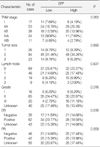Abstract
Purpose
To evaluate the significance of the S-phase fraction (SPF) and DNA ploidy, determined by DNA flow cytometry, as prognostic markers in invasive breast cancer.
Methods
Between October 1986 and June 1999, 143 breast carcinoma patients, treated by surgery, were analyzed. Flow cytometry was performed for the identification of the SPF and DNA ploidy, with immunohistochemistry performed on paraffin embedded material for the hormone receptor. Two SPF classes were defined on the basis of the median value (10) by using a log rank test (high SPF>10, low SPF<10). The correlation between SPF and the clinicopathological factors (tumor size, lymph node status, histological grade and steroid receptor status) and between the SPF and 5 yr disease-free survival (DFS) were investigated.
Results
DNA ploidy was not associated with tumor size, lymph node status, histological grade, overall survival and DFS. In a univariate analysis, high SPF values were associated with shorter 5 yr DFS in individual groups. In the node negative group, the 5 yr DFS of the low SPF group was higher than that of the high SPF group, but in the node positive group, the SPF values showed statistical significance with the 5 yr DFS. In a multivariate analysis, the SPF was independently associated with the 5 yr DFS in the node negative group.
Figures and Tables
 | Fig 1Univariate survival analysis according to s-phase fraction tertiles: overall survival (A) and disease free survival (B) in the overall patients. |
 | Fig 2Disease free survival according to s-phase fraction tertiles in subgroups. (A) T2 patient, (B) T3 patient, (C) node-negative patients, (D) node-positive patients. |
 | Fig 3Disease free survival according to s-phase fraction tertiles in subgroups. (A) estrogen receptor positive patient, (B) estrogen receptor negative patient, (C) progesterone receptor negative patients, (D) progesterone receptor positive patients. |
References
2. Michels JJ, Marnay J, Delozier T, Denoux Y, Chasle J. Proliferative activity in primary breast carcinomas is a salient prognostic factor. Cancer. 2004. 100:455–464.

3. van Diest PJ, Michalides RJ, Jannink L, van der Valk P, Peterse HL, de Jong JS, et al. Cyclin D1 expression in invasive breast cancer. Correlations and prognostic value. Am J Pathol. 1997. 150:705–711.
4. Pinto A, André S, Laranjeira C, Soares J. Correlations of cell cycle regulators (p53, p21, pRb and mdm2) and c-erbB-2 with biological markers of proliferation and overall survival in breast cancer. Pathology. 2005. 37:45–50.

5. Louwman WJ, van Beek MW, Schapers RF, Tutein Nolthenius-Puylaert MB, van Diest PJ, Roumen RM, et al. Long-term survival of T1 and T2 lymph node-negative breast cancer patients according to mitotic activity index: a population-based study. Int J Cancer. 2006. 118:2310–2314.

6. Moureau-Zabotta L, Bouchet C, Cesari D, Uzan S, Lefrance JP, Antoine M, et al. Combined flow cytometry determination of S-phase fraction and DNA ploidy is an independent prognostic factor in node negative invasive breast cancer: analysis of a series of 271 patients with stage 1 and 2 breast cancer. Breast Cancer Res Treat. 2005. 91:61–71.

7. Chassevent A, Jourdan ML, Roman S, Descotes F, Colonna M, Martin PM, et al. S-phase fraction and DNA ploidy in 633 T1, T2 breast cancers: a standardized flow cytometric study. Clin Cancer Res. 2001. 7:909–917.
8. Colozza M, Azambuja E, Cardoso F, Sotiriou C, Larsimont D, Piccart PJ. Proliferative markers as prognostic and predictive tools in early breast cancer: where are we now? Ann Oncol. 2005. 16:1723–1739.

9. Chassevent A, Jourdan ML, Ferrero-Pous M, Colonna M, Romain S, Spyratos F, et al. Standardization and quality control in the evaluation of proliferation parameters in T1, T2, N0N1, M0 breast cancer: multicentric retrospective study. II. DNA-ploidy and S-phase fraction. Bull Cancer. 1999. 86:685–691.
10. Kim SI, Park BW, Kim SK, Lee KS. Prognostic value for the S-phase fraction in T1, T2, node negative breast cancer. J Breast Cancer. 2005. 8:27–33.

11. D'hautcourt JL, Spyratos F, Chassevent A. Quality control study by the French Cytometry Association on flow cytometric DNA content and S-phase fraction (S%). Cytometry. 1996. 26:32–39.
12. Baldetorp B, Bendahl PO, Ferno M, Alanen K, Delle U, Falkmer U, et al. Reproducibility in DNA flow cytometric analysis of breast cancer: comparison of 12 laboratories' results for 67 sample homogenates. Cytometry. 1995. 22:115–127.

13. Vielh P, Carton M, Padoy E, deRycke Y, Klijanienko J, El-Naggar AK, et al. S-phase fraction as an independent prognostic factor of long-term overall survival in patients with early-stage or locally advanced invasive breast carcinoma. Cancer. 2005. 105:476–482.

14. Michels JJ, Marnay J, Plancoulaine B, Chasle J. Flow cytometry in primary breast carcinomas: prognostic impact of S-phase fraction according to different analysis patterns. Cytometry B Clin Cytom. 2004. 59:32–39.

15. Adeyinka A, Baldetorp B, Mertens F, Olsson H, Johannsson O, Heim S, et al. Comparative cytogenetic and DNA flow cytometric analysis of 242 primary breast carcinomas. Cancer Genet Cytogenet. 2003. 147:62–67.

16. Jourdan ML, Ferrero-Pous M, Spyratos F, Romain S, Martin PM, Chassevent A. Flow cytometric S-phase fraction measurement in breast carcinoma: influence of software and histogram resolution. Cytometry. 2002. 48:66–70.

17. Page DL, Gray R, Allred DC, Dressler LG, Hatfield AK, Martino S, et al. Prediction of node-negative breast cancer outcome by histologic grading and S-phase analysis by flow cytometry: an Eastern Cooperative Oncology Group Study (2192). Am J Clin Oncol. 2001. 24:10–18.

18. Dressler LG, Seamer L, Owens MA, Clark GM, McGuire WL. Evaluation of a modeling system for S-phase estimation in breast cancer by flow cytometry. Cancer. 1987. 47:5294–5302.




 PDF
PDF ePub
ePub Citation
Citation Print
Print




 XML Download
XML Download